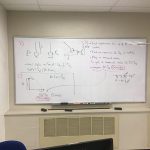
We caught up with Tim Walton, who received his Ph.D. in 2016. Walton currently works at a plasma physics software company in Madison, WI called Prism. He also recently was a 2nd author on a recent Nature paper with his former Ph.D. advisor, Bill Fairbank.
Walton started out with a B.S. in mathematics with a minor in physics from the University of Wisconsin, Platteville, but he decided he preferred the pursuit of physics, and rounded out his undergrad in physics by taking quantum mechanics at the University of Wisconsin, Madison while working at a cheese shop. The physics department here at CSU appealed to him because of the variety of very impressive research.
Walton admits he started with a lot of anxiety and uncertainty, but he quickly found a community with the other grad students. The experience of being a teaching assistant and giving talks about his research helped him immensely in working through a severe fear of public speaking. He soon joined Bill Fairbank’s group, researching a method to detect single Barium atoms in solid Xenon with application to a large collaborative double beta decay experiment.
Walton enjoyed the research because the work combined the frontier of fundamental particle physics with a bold exploration of a novel technique, imaging single atoms trapped in a noble gas, which had never been done until Bill’s group demonstrated it very recently. “Though I never thought I would work in a lab setting, I gradually became confident and effective,” Walton said. “By the end of my time at CSU, I was turning out good research results at a good pace.”
In his current role at Prism, they have a few codes which simulate the hydrodynamics and spectral properties of plasmas. CSU’s codes are used by multiple national labs and universities to simulate observables in their experiments, including but not limited to large-scale inertial confinement fusion experiments. Of his work, Walton said “one thing that excites me is the prospect of finally harnessing fusion power on Earth.”


